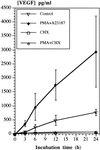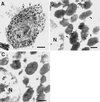Synthesis, storage, and release of vascular endothelial growth factor/vascular permeability factor (VEGF/VPF) by human mast cells: implications for the biological significance of VEGF206
- PMID: 9529385
- PMCID: PMC25314
- DOI: 10.1091/mbc.9.4.875
Synthesis, storage, and release of vascular endothelial growth factor/vascular permeability factor (VEGF/VPF) by human mast cells: implications for the biological significance of VEGF206
Abstract
Mast cells have been implicated in various diseases that are accompanied by neovascularization. The exact mechanisms by which mast cells might mediate an angiogenic response, however, are unclear and therefore, we have investigated the possible expression of vascular endothelial growth factor/vascular permeability factor (VEGF/VPF) in the human mast cell line HMC-1 and in human skin mast cells. Reverse transcription-polymerase chain reaction (RT-PCR) analysis revealed that mast cells constitutively express VEGF121, VEGF165, and VEGF189. After a prolonged stimulation of cells for 24 h with phorbol 12-myristate 13-acetate (PMA) and the ionophore A23187, an additional transcript representing VEGF206 was detectable, as could be verified by sequence analysis. These results were confirmed at the protein level by Western blot analysis. When the amounts of VEGF released under unstimulated and stimulated conditions were compared, a significant increase was detectable after stimulation of cells. Human microvascular endothelial cells (HMVEC) responded to the supernatant of unstimulated HMC-1 cells with a dose-dependent mitogenic effect, neutralizable up to 90% in the presence of a VEGF-specific monoclonal antibody. Flow cytometry and postembedding immunoelectron microscopy were used to detect VEGF in its cell-associated form. VEGF was exclusively detectable in the secretory granules of isolated human skin mast cells. These results show that both normal and leukemic human mast cells constitutively express bioactive VEGF. Furthermore, this study contributes to the understanding of the physiological role of the strongly heparin-binding VEGF isoforms, since these were found for the first time to be expressed in an activation-dependent manner in HMC-1 cells.
Figures








Similar articles
-
Mast cells can secrete vascular permeability factor/ vascular endothelial cell growth factor and exhibit enhanced release after immunoglobulin E-dependent upregulation of fc epsilon receptor I expression.J Exp Med. 1998 Sep 21;188(6):1135-45. doi: 10.1084/jem.188.6.1135. J Exp Med. 1998. PMID: 9743532 Free PMC article.
-
Angiotensin II stimulates the synthesis and secretion of vascular permeability factor/vascular endothelial growth factor in human mesangial cells.J Am Soc Nephrol. 1999 Feb;10(2):245-55. doi: 10.1681/ASN.V102245. J Am Soc Nephrol. 1999. PMID: 10215323
-
The vascular endothelial growth factor (VEGF) isoforms: differential deposition into the subepithelial extracellular matrix and bioactivity of extracellular matrix-bound VEGF.Mol Biol Cell. 1993 Dec;4(12):1317-26. doi: 10.1091/mbc.4.12.1317. Mol Biol Cell. 1993. PMID: 8167412 Free PMC article.
-
Vascular endothelial growth factor: the key mediator in pleural effusion formation.Curr Opin Pulm Med. 2002 Jul;8(4):294-301. doi: 10.1097/00063198-200207000-00009. Curr Opin Pulm Med. 2002. PMID: 12055392 Review.
-
Vascular endothelial growth factor from embryonic status to cardiovascular pathology.Rep Biochem Mol Biol. 2014 Apr;2(2):59-69. Rep Biochem Mol Biol. 2014. PMID: 26989723 Free PMC article. Review.
Cited by
-
Mast cells in human and experimental cardiometabolic diseases.Nat Rev Cardiol. 2015 Nov;12(11):643-58. doi: 10.1038/nrcardio.2015.117. Epub 2015 Aug 11. Nat Rev Cardiol. 2015. PMID: 26259935 Review.
-
Preformed enzymes in mast cell granules and their potential role in allergic rhinitis.Curr Allergy Asthma Rep. 2003 May;3(3):266-72. doi: 10.1007/s11882-003-0049-y. Curr Allergy Asthma Rep. 2003. PMID: 12662477 Review.
-
Proposed Pathogenesis of Diffuse Alveolar Hemorrhage in Idiopathic Pulmonary Hemosiderosis.Lung. 2022 Apr;200(2):205-215. doi: 10.1007/s00408-022-00523-4. Epub 2022 Mar 10. Lung. 2022. PMID: 35267072 Review.
-
The tumor microenvironment in colorectal carcinogenesis.Cancer Microenviron. 2010 Mar 5;3(1):149-66. doi: 10.1007/s12307-010-0038-3. Cancer Microenviron. 2010. PMID: 21209781 Free PMC article.
-
Human Skin-Derived Mast Cells Spontaneously Secrete Several Angiogenesis-Related Factors.Front Immunol. 2019 Jun 25;10:1445. doi: 10.3389/fimmu.2019.01445. eCollection 2019. Front Immunol. 2019. PMID: 31293594 Free PMC article.
References
-
- Bacic M, Edwards NA, Merrill MJ. Differential expression of vascular endothelial growth factor (vascular permeability factor) forms in rat tissue. Growth Factor. 1995;12:11–15. - PubMed
-
- Butterfield JH, Weiler D, Dewald G, Gleich G, Gleich GJ. Establishment of an immature mast cell line from a patient with mast cell leukemia. Leuk Res. 1988;12:345–350. - PubMed
Publication types
MeSH terms
Substances
LinkOut - more resources
Full Text Sources
Other Literature Sources

